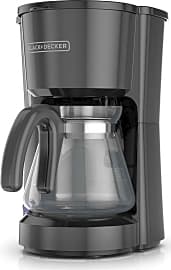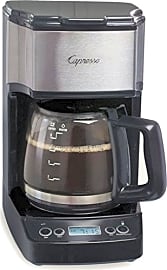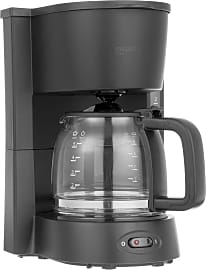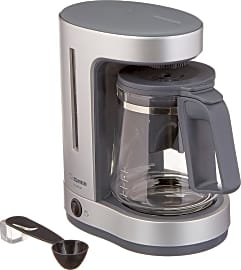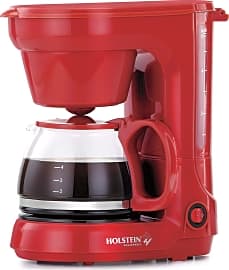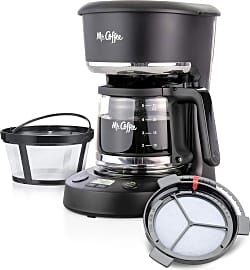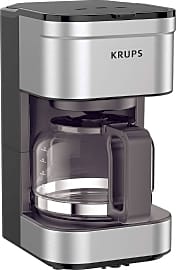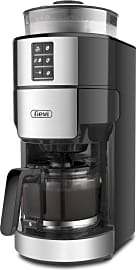The 10 Best 5-Cup Coffee Makers

This wiki has been updated 34 times since it was first published in April of 2016. Single people usually don't require a giant pot of coffee, but machines that use plastic pods create unnecessary trash. One of these 5-cup makers will allow you to brew just the right amount while cutting down on waste. Despite their compact size, many of them offer the same features as larger models, so you can enjoy all the conveniences without a huge appliance hogging space on your countertop. When users buy our independently chosen editorial choices, we may earn commissions to help fund the Wiki.
Editor's Notes
November 21, 2020:
One big thing to note about these five-cup coffee makers is that for most brands, one "cup" is five ounces. That means you're going to get 25 ounces per pot, with slight variations depending on the maker. Many people want more than that, which is why they go with standard 12-cup units. Those who want a freshly-brewed mug every time can go with a single-serve coffee maker. This list is for those in between, who want a compact machine that delivers more than one cup of coffee without the use of pods.
If you're in the market for one of these, you likely want to save money on a maker that's suited for a personal office or dorm room. That makes a unit like the Gevi Programmable, which is large and expensive, a bit impractical even though it allows for grinding. Since most of these units are inexpensive, the question is how cheap you want to go. If you don't care about having a timer, the Black and Decker CM0700BZ, AmazonBasics Glass, and Holstein Housewares HH-0914701 are all solid. But to wake up to fresh coffee, go with the Mr. Coffee CGX7-RB or Capresso Black.
The Hario Technica is top dog because it transcends its size and provides a completely different experience from the rest of the units in the category, putting it in a different league than the competition.
December 11, 2019:
For small families or java drinkers who live alone, often a standard size coffee maker is too large for your needs. If that’s the case for you, the five-cup models here feature all the bells and whistles of the bigger models (like a programmable brew time, pause-and-pour functions, and reusable mesh filters), just with a scaled-down size.
Two models join the selection today, including the Mr. Coffee CGX7-RB, a choice from a well-known brand that’s been around since the 1970s. It conveniently pauses brewing when you remove the carafe to pour a cup, and it can be programmed easily to brew at a later time, so you can have your coffee ready and waiting when your alarm clock goes off. It features bright LED indicators and time display.
For a model with a filter basket that’s conveniently dishwasher friendly, look to the newly added Black+Decker DCM600B, which also offers handy built-in cord storage and a small footprint that makes it nice for the kitchen of any small office, apartment, or condo. While it does have a light-up on-off switch, this one does not, however, come with a clock.
In this update, we also replaced the old model from Holstein Housewares with a newer one, the Holstein Housewares HH-0914701. This vibrant choice comes in either bright red or eye-catching teal, either of which will add a fun pop of color to any kitchen. While it’s sure to stand out, it’s also a basic, no-frills model that doesn’t offer a digital display or automatic shutoff. It’s simple to operate and a great choice for anyone who doesn’t want anything digital on their coffee maker.
Special Honors
Farberware 5 Cup Programmable Available exclusively from Walmart, this sturdy model can be programmed to start brewing at a later time, which is nice when you want to wake up to the invigorating smell off hot coffee. Its precision-pour carafe has a plastic lip for a dripless, mess-free pour. It’s got a simplified control panel and a chlorine filter that cleans the water before brewing. farberwareproducts.com
Bella Pro Series Cup Coffee Maker Made with a 650-watt brewing system, this compact choice will look great on your countertop without hogging too much space. You can get in an early cup while it’s still brewing, thanks to its handy pause-and-serve feature. Its easy-flow carafe spout will keep it from spilling, while its keep-warm function ensures a nice, hot cup of java throughout the morning. It comes with a measuring scoop and a removable and reusable filter basket, so you can stop buying paper ones that aren’t friendly to the environment. bellahousewares.com
How to Choose The Right Accessories For Your Coffee Maker
Cream is richer and more textured, but milk contains less fat.
The most important accessory for any coffee maker is a mug. Porcelain mugs are preferable to earthenware in that they insulate the contents better, keeping coffee warm for an extended period of time. Porcelain mugs are also smooth and durable, which makes for easy washing. China mugs, while appropriate for formal occasions, are generally considered too delicate for drinking coffee on a day-to-day basis. Sealed mugs are great for avoiding spills on the road, whereas thermoses are recommended for locking in several hours of flavor and warmth.
Flavor is a major concern when it comes to coffee, which is why aficionados tend to use paper filters as opposed to permanent ones. Whereas a permanent filter can effectively eliminate some minor costs, its built-in pores allow for individual grains, or drops of oil, to filter through. Bean oil tends to oxidize quickly and that, in turn, might brunt a coffee's taste. Paper filters are less permeable, and disposable, which leads to purer coffee, and less to wash.
Certain coffee drinkers are very particular about using milk as opposed to cream (or half and half), which is why it's best to keep both of these on hand. Cream is richer and more textured, but milk contains less fat. Powdered creamer might be preferable in any non-refrigerated setting where milk might curdle or go bad.
As far as coffee sweeteners go, a lot of artificial sweeteners contain fewer calories than sugar, but these sweeteners are also, well, sweeter than sugar, and a lot of them have been refined by way of non-organic processes. Sugar, despite its downsides, remains the devil that we know.
When it comes to stirring coffee, metal spoons are more appropriate for private settings or formal affairs, whereas disposable stirrers are more appropriate for a public setting or an office. Plastic stirrers are generally cheaper than wooden stirrers, but wooden stirrers are more sturdy and they can be recycled or composted.
How to Clean Your 5-Cup Coffee Maker
If you use your coffee maker on a daily basis, it's important to do more than simply wash and rinse the pot. A coffee maker's reservoir and basket can yield significant mildew and other bacteria if left unchecked for more than a month. The good news is that cleaning a coffee maker is easy. Doing so requires little more than a dish towel, a bottle of vinegar, some paper towels, and some running water.
This is a result of the vinegar having eliminated some of the caked-on dirt that was clogging the filtration system and its tubes.
First, empty out your coffee pot along with any remaining filters from the basket overhead. Use a damp paper towel to run along the inside of the reservoir, collecting any grime or individual grains that have fastened themselves to the reservoir walls. Once that's done, fill your coffee pot with an equal combination of white vinegar and water. Dump the solution from the pot into your coffee maker's reservoir, and then close the lid and turn the coffee maker on.
Allow the solution to run through, as if you were boiling a pot of coffee. Once the pot is full, dispose of the vinegar and water, and then repeat the process a second time. During the second run you're likely to notice that the solution is dripping down and through into the pot much faster. This is a result of the vinegar having eliminated some of the caked-on dirt that was clogging the filtration system and its tubes.
After you've disposed of the solution a second time, fill the coffee pot with hot water - and nothing else - and then run the hot water through the coffee maker to cleanse the reservoir and its tubes. Once you're done, rinse out your coffee pot and your basket, and then wipe down the walls inside the reservoir. Repeat this process once a month for the best results.
A Brief History of The Coffee Maker
Making coffee is simple. You roast some beans, you grind those beans, and then you boil those beans with water, allowing the flavor to seep in. For centuries, this was achieved with little more than a pot (or a pan) and a still-burning flame.
This was a result of electric coffee makers arriving on the scene.
The process of brewing coffee by way of a drip filter was originated in France during the eighteenth century. Early filters were made of non-disposable materials, like burlap or cloth, with the only significant issue being that - over time - a ragged filter might negatively affect the coffee's taste. This problem was solved by a British physicist named Benjamin Thompson who invented the pumping percolator - a free-standing kettle which “perked” coffee by continually cycling boiled water through fresh beans.
Despite remaining a household item throughout most of the twentieth century, the coffee percolator became outdated during the 1980's - relegated to the catering tables of cheap hotels and banquet halls. This was a result of electric coffee makers arriving on the scene. These new coffee makers followed a similar brewing process, but they were sleeker, their pots were lighter (and transparent), and the majority of models featured an automatic timer, so a fresh pot could be brewing before a person even woke up from their sleep.
Today's coffee makers are largely electronic or even digital. Commercial coffee makers are capable of brewing more coffee, faster, whereas designer coffee makers are specifically engineered for brewing one cup at a time. The overwhelming lot of electric coffee makers are designed for simplicity. Their only goal is to brew a delicious pot of coffee almost instantly - very often with the touch of a button - and then to keep that pot of coffee warm.



